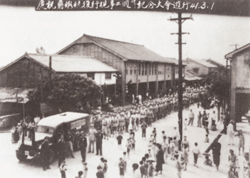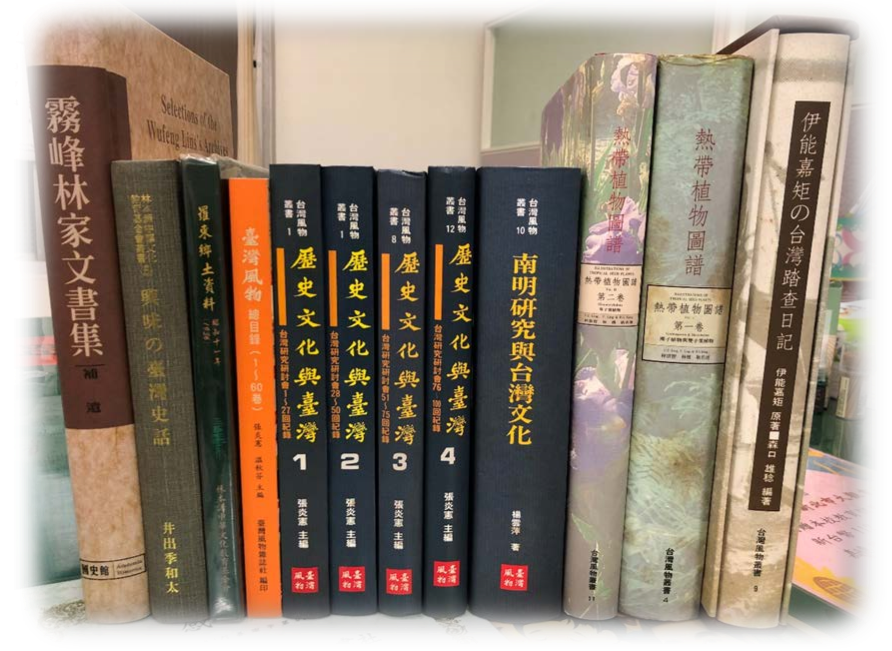 蔣政權流亡入台
蔣政權流亡入台
Exile of the Chiang K’ai-shek regime to Taiwan
李筱峰/Li Hsiao-feng
2001-12-10
 Military parade in commemoration of the 2nd anniversary of Chiang K’ai-shek’s
Military parade in commemoration of the 2nd anniversary of Chiang K’ai-shek’s
“Second Coming” [resumption of office as president] (Courtesy of Hung Tsung-yi)
1949 年 12月 7日中國國民黨主政的中華民國政府棄守中國大陸,撤退到台灣,這是台灣史上的一件大事。隨國民黨政權流亡進入台灣的大批軍民,在經濟、政治、社會等各方面對台灣造成什麼樣的影響?而其中有哪些影響仍在持續發酵中?本週台灣歷史之窗特別邀請世新大學李筱峰教授執筆,分析半個世紀以來,蔣流亡政權與新移民在台灣史中所扮演的角色及其影響。
On December 7, 1949, the Kuomintang-led government of the Republic of China gave up defense of its sovereignty over the Chinese mainland and retreated into exile in Taiwan — a momentous event in the history of Taiwan. What economic, political and social influences did the large number of troops accompanying the KMT regime have on Taiwan? And which among those influences continue to ferment in Taiwan to this day? For this week’s installment of Window on Taiwan, the Taiwan News has invited Professor Li Hsiao-feng of Shih Hsin University to provide an analysis of the roles played by, and the influences of, the exiled Chiang K’ai-shek regime and new immigrants to Taiwan.
二次大戰結束後約半年,國民黨與共產黨之間的軍事衝突又起。1948年末,戰局轉趨對共軍有利。腐敗的蔣介石政權在經濟崩潰、民心漸失的環境中,節節敗退。1949 年1 月21 日, 總統蔣介石被逼引退下台 (但仍暗中操縱政局 ) , 由副總統李宗仁代理。但大勢已去,難以挽回。共軍渡過長江後,佔領南京,國民黨政府由南京遷往廣州 (2月1日) ,再由廣州遷往重慶 (9月7日) 。毛澤東於10月1 日在北京主持中華人民共和國的開國大典。 12月7 日國民黨政權退入台灣。蔣介石則早在 6月24日到台北,選定陽明山設立「總裁辦公室」 (8月1日成立)。他並於翌年3月1日復職,繼續出任總統。
About half a year after the conclusion of World War II, military hostilities between the Kuomintang and the Chinese Communist Party resumed, and during 1948, the advantage began tilting in favor of the CCP military. Under the influences of economic collapse and loss in public confidence, the corrupt Chiang K’ai-shek regime suffered defeat upon defeat. On January 21, 1949, President Chiang was forced to retire from office, though still manipulating the government from behind the scenes, while Vice President Li Tsung-jen took over as acting president. The chance for recovering the advantage had already passed, however, and there was no possibility of saving the day. When the communist troops crossed the Yangzi River and occupied Nanjing, the KMT government moved southward to Guangzhou (February 1) and subsequently to Chongqing (September 7). On October 1, Mao Tse-tung presided over the ceremony for establishment of the People’s Republic of China in Beijing, and on December 7, the KMT regime retreated to Taiwan. Earlier, on June 24, Chiang K’ai-shek had arrived in Taipei and selected Yangmingshan as the site of the “Office of the Generalissimo,” which was established on August 1. On March 1, 1949, he resumed the post of president.
人口大增,經濟受累
國民黨政權在潰逃之前,其統治下的大陸經濟體系正迅速走向崩潰,台灣受其牽累,加劇台灣經濟的混亂。而隨著國民黨政權的潰敗,大批軍民陸續逃入台灣,一時人口驟增,帶給台灣社會更大的壓力。終戰之初,台灣人口僅600多萬人,但從 1946 年到 1952 年的7年間,台灣共增加了約200萬人,其中僅1949年到1950年的大逃亡就進入了軍民約100萬人。這些突然湧入的人口,又不是第一線生產線上的人口,因此台灣一時承受極大的經濟壓力。人口開始大增的 1948年和1949年,也是台灣通貨膨脹最嚴重的時期。1949年6 月台灣的物價指數,已是終戰之初的 7000多倍。令人難以忘懷的「四萬元換一元」的新台幣發行,也在此時開始。
Economic disruption from massive influx of immigrants
Prior to the rout of the KMT government, the mainland economy had rapidly deteriorated to the point of collapse under its rule, with serious repercussions in Taiwan, aggravating its [already existing post-war] economic disarray. And following the KMT government’s defeat on the mainland, the arrivals of wave upon wave of government soldiers in Taiwan and the consequent sudden jump in Taiwan’s population exerted an even greater pressure upon Taiwan society. As of the end of WW II, Taiwan’s population was only about 6 million, whereas between the period 1946-1952 it increased by an additional 2 million more or less, including about 1 million soldiers who fled the mainland between 1949 and 1950. The period of greatest population influx, from 1948-1949, also coincided with the period of most severe currency inflation. In June of 1949, the consumer goods price index stood at 7000 times greater than at the end of the WW II. Unforgettably, it was also in this year that the 40,000: 1 rate of conversion to the New Taiwan Dollar was instituted.
工作特權與居住環境的隔離
再者,在短期間移入台灣的大陸人儼然成為一大族群,加以國民黨政府的各機關要職仍以大陸人為主導,位居要津。再加上眷區眷村等族群隔離政策的施行,使得自二二八事件以後無法一時彌補的族群間的矛盾,延續相當長的時間才逐漸淡化。
Job favoritism and residential segregation
Furthermore, the mainlander immigrants shortly became an exalted social group in Taiwan, holding all of the head positions in the various agencies of the KMT government. And due to the government’s ethnic segregation policy of establishing special housing complexes and residential areas reserved for mainland soldiers and government workers, following the February 28 Incident [in 1947, which marked the beginning of the “White Terror” in which thousands of Taiwan people, especially intellectuals, were rounded up and executed], it was difficult to immediately resolve ethnic animus, which only gradually abated over a prolonged period of time.
政治性的質變
除了人口的壓力、族群的問題之外,對台灣產生結構性影響的,應該是政治性質的改變。其實,隨著國民黨政權的敗逃台灣,1912年所建立的中華民國已經結束了。流亡來到台灣的蔣政權,雖然在台灣仍掛著「中華民國」名號,但其內容卻迥然不同。1912年開國時的中華民國,其領土範圍並沒有包括台灣﹔但1949以後掛名叫做「中華民國」的,其統治範圍卻幾乎只有台灣,而沒有大陸。國號雖然相同,但其範圍剛好顛倒過來。
Transformation of political reality
Besides population pressure and ethnic problems, what probably exerted the greatest influence on Taiwan’s social structure was political change. In fact, after the KMT regime fled in defeat to Taiwan, the Republic of China established in 1912 came to an end. Although the exiled Chiang K’ai-shek regime continued to nominally treat Taiwan as “the Republic of China,” the content actually denoted by that name was utterly different from the prior reality: The territory of the Republic of China established in 1912 had not included Taiwan; but after 1949, the effective sphere of sovereignty of the land referred to as “the Republic of China” was almost nothing more than Taiwan and did not include the mainland. While their names were the same, the before-and-after territories signified by that name were almost totally contrary in scope [save for a few little islands in the Taiwan Strait].
在 1912年建立的中華民國,在 1949結束後,其原先的掌政者 (蔣介石統治集團) 拿著原先的「中華民國」名號,流亡到原本沒有參加中華民國建國的台灣,繼續維持其政權。原先代表範圍僅限於大陸 ( 不包括台灣)的所謂 「 國旗 」(其實沒有經過民主法定程序,純然由一黨制定的「青天白日滿地紅旗」),在1949年之後卻只能拿到原本不在其代表範圍之內的台灣來插掛。所謂的「國歌」(其實是中國國民黨黨歌),也是如此。至於,在中國大陸上醞釀、設計的「中華民國憲法」,現在也只能拿來原本沒有參加中華民國建國的台灣來修修補補。雖然有人說,台灣在1945年10月25日到1949年底之間,已經納入中華民國範圍。其實此時期的台灣,因尚未正式簽訂中日和約來確定台灣的領土歸屬,所以還在地位未定的階段。
After the Republic of China established in 1912 came to an end in 1949, its erstwhile governors, Chiang K’ai-shek’s ruling group, brought the name of that erstwhile country with them into exile in a Taiwan which had not taken part in the establishment of the ROC in order to keep alive their claim to power. After 1949, the so-called “national flag” (the “blue sky, white sun, red earth” banner, which in fact was never formally adopted as the ROC national flag through democratic legal procedure but was unilaterally imposed by a single party), which had originally signified only mainland China without Taiwan, could only be planted on a Taiwan soil which had never been a part of the territory it symbolized. The same goes for the “national anthem,” which was actually the KMT Party Song. Consequently, Taiwan has been left in the curious position of having to amend in haphazard fashion a “Constitution of the Republic of China” developed and designed in and for a bygone mainland country in whose establishment Taiwan took no part. Although there are those who say that during the period between October 25, 1945 until the end of 1949 Taiwan had already become a territory of the Republic of China, the fact is that during that period its status was as yet undetermined inasmuch as the WW II Sino-Japanese Peace Treaty which defined its territorial sovereignty had not yet been formally signed.
 Soldiers retreating to Taiwan after the Kuomintang regime
Soldiers retreating to Taiwan after the Kuomintang regime
had been soundly defeated on the Chinese mainland.
無怪乎,隔年 ( 1950 . 3 . 13 ) 蔣介石在陽明山莊演講<復職的使命與目的>時坦白說:「我們的中華民國到去年終就隨大陸淪陷而已滅亡了,我們今天都已成了亡國之民,…」
No wonder, then, that in the following year, in his March 3, 1950 address delivered from his Yangmingshan villa, entitled “Mission and Objective of My Resumption of Office,” Chiang K’ai-shek himself candidly stated, “Our Republic of China ceased to exist at the end of last year with the fall of the mainland, and we today have all become its orphaned people…”
台灣的國家型態,自1949年底以後,竟出現這種世界罕見的型態。他的國旗、國歌、憲法,都是由外面一個已經結束的國家帶進來的。
Taiwan’s national status following the end of 1949 thus became an anomalous one hardly ever seen in the world. Its national flag, national anthem and constitution were all transplants from a country which had expired.
這樣的國家型態,正如學者Ronald Weitzer所謂的「遷佔者政權」(Settler State)。根據Ronald Weitzer 在其所著《遷佔者國家的轉型》 ( Transforming Settler State, Communal Conflict and Security in Northen Ireland and Zimbabwe ) 一書中指出:「遷佔者國家」是「由支配原始居民的新移民所建立的國所建立起的政治系統,家」,「遷佔者對於原來遷出的母國,或是實際上,或是法理上,均已經獨立;這個系統的目的是為了保有遷佔者的政治優勢地位。」自1949年底以後,國民黨政權撤出其原鄉母土,播遷入台,建立其統治地位,使台灣成為「遷佔者國家」的形態。
This sort of national status is exactly the one characterized by scholar Ronald Weitzer as a “settler state.” As the book ” Settler State Transformation: Communal Conflict and Security in Northern Ireland and Zimbabwe,” Weizer states that a “settler state” is “a state established by new immigrants who exercise control over its original native inhabitants” …. “The political system established by the settlers, whether in practical effect or in legal theory, is in any case independent of the mother country which they abandoned. The aim of such a political system is to preserve the settlers’ priviledged political status.” From the end of 1949 onward, having vacated its homeland and transplanted itself in Taiwan, the KMT regime established its position as ruler, thus conferring upon Taiwan the status of “settler state.”
這個「遷佔者國家」的國民黨政權在台灣設計的國家架構,是以全中國為標準。儘管國民黨政府早已退出中國母土,但在國家認同上,卻仍以其母土作為認同的指標。他們宣稱有朝一日會「中興復國」,因此他們編寫中國古代封建時期的故事「田單復國」「少康中興」,來「教育」台灣人,要他們「毋忘在莒」。整套教育內容,及價值體系,是以大中國為座標來思考,完全沒有台灣的主體性,灌輸人民對其中國山河的感情,以及對領袖的效忠,而不是對台灣歷史的瞭解,當然也沒有現代國家意識的培養。雖然帶入一部規定有自由、民權內容的憲法,可是卻以「動員戡亂」的名目,以及戒嚴法,凍結憲法有關自由、民權的內容。在其「戡亂體制」下,蔣介石權力甚大,國會則不需改選,由大陸來台的第一屆民意代表繼續充當立委、監委及國大。在外交上,則自稱是代表全中國的唯一合法政府。總之,蔣介石流亡入台後,是一個「一黨專政」與「個人獨裁」的政治體制,在蔣介石主政的26年間,台灣人為了成就蔣介石的「反共復國」的政治迷思,在內政、外交、社會等多方面犧牲不少人力、物力和時光。今天許多問題的癥結也種因於此。
The nation-defining conceptual framework designed by this settler-state KMT regime in Taiwan was that of a nation encompassing the whole of China. Despite the fact that the KMT regime had long since abandoned its China homeland, it nevertheless took that homeland as its basis for national identity. Vowing to once more “revive and recover the nation,” they composed stories based on the ancient feudal era of Chinese history, such as “Tien Tan Recovers the Kingdom” [referring to General Tien Tan of the state of Chi (齊) during the Warring States period, who recovered his homeland from the hands of Yen (燕) invaders] or “Shao Kang Revives the Kingdom” [referring to the ruler who saved the Hsia Dynasty from demise], in order to “educate” Taiwan’s people, urging them “Don’t forget the time at Chu” [referring to a battle in Chinese history whereby the hero turned the near defeat and humiliation of the state of Chu (筥) into glorious victory]. The entire content of their educational and values systems took China as its foundation of thought, without the least vestige of native Taiwan identity. Its aim was to instill in the public an affection for their Chinese homeland and filial loyalty to the paramount leader, embodying neither any understanding of Taiwan history nor any cultivation of modern-day national consciousness. Although the KMT settlers brought with them a constitution stipulating freedom and people’s rights, they could nevertheless freeze constitutional provisions regarding freedom and people’s rights in the name of “Mobilization for the Suppression of Communist Rebellion” laws and the need for martial law. Under these laws Chiang K’ai-shek was granted great personal power, and representative assembly elections were no longer required, with the original group of representatives from the mainland continued occupying in their seats in the Legislative Yuan, Control Yuan, and National Assembly. On the diplomatic front, the KMT regime claimed to be the sole legal government of all of China. In sum, after Chiang K’ai-shek’s exile to Taiwan, totalitarian one-party rule led by a one-man dictator became the political system of Taiwan, and during the 26 years of Chiang-led rule, for the sake of realizing his political obsession with “overthrowing the communists and reviving the country,” the people of Taiwan were forced to make tremendous sacrifices in manpower, materiel and time on domestic governmental, foreign diplomatic and social fronts. Therein lies the ultimate source of so many problems currently dogging Taiwan.
台灣與中國持續分隔的歷史之必然
最後還值得一提的,蔣政權移入台灣,使台灣與中國之間又分隔開來。經過五十年的日本統治,台灣與中國之間已有極大差異。戰後那四年之間,又發生二二八事件的衝突,雙方未及充分交流,蔣政權就匆匆流亡入台,台灣與中國之間,至此一隔又半世紀以上。這樣的歷史發展,使得海峽雙方發展成兩個國家,似乎是歷史演變的必然。
Separation of Taiwan and China:a matter of historical inevitability
Worth noting, in conclusion, is the fact that the Chiang regime’s exile to Taiwan resulted in continuation of alienation between Taiwan and China. A half century of Japanese rule had earlier produced a conspicuous difference between Taiwan and China. In the 4-year interregnum after WW II, there also occurred the February 28 Incident [which spoiled the chance for harmonization of mainland Chinese and Taiwan’s native inhabitants], and before the two sides had any opportunity for deep-reaching interchange, the Chiang regime scurried into exile in Taiwan, bringing about a further half-century-plus of estrangement between Taiwan and China continuing to this day. This course of history has caused the two sides of the Taiwan Straits to develop into two different countries, the seemingly inevitable outcome of such historical evolution.
Edited by Hsu, Shiou-Iuan/ translated by Elizabeth Hoile
(李美儀編輯/曹篤明翻譯)









